FTA (изд-во). Flexography: Principles And Practices. Vol.1-6
Подождите немного. Документ загружается.


Another type of tension trim system is used
on rewinds. The transducer signal is again
used to control torque within a narrow range,
but the operating torque level is determined
by roll diameter as well as speed. The diame-
ter is calculated by a roll follower as
described earlier.
Tension control is of primary importance in
the processing of continuous webs. Better
quality and profits are possible through
improvements in tension control. Manual sys-
tems and roll followers are the cheapest in
terms of purchase cost, but sophisticated con-
trols involving measurement of tension allow
faster operating speeds and consistent results
with reduced waste and less labor cost.
Advantages of Transducers over Dancer-Roll
Systems. The transducer’s ability to measure
actual web tension is the single biggest dif-
ference from all other types of tension con-
trols, and it provides the transducer system
tremendous advantages. The most obvious
of these advantages is the analog meter or
digital display. No other system offers a dis-
play of actual web tension. It eliminates all
the guesswork.
The next advantage is accuracy. The
closed tension loop enables the controller to
automatically and quickly compensate for
factors affecting tension, including changes
of speed, roll diameter, web characteristics
and brake fade. The result is a typical system
accuracy of 2% to 3%. The third advantage is
ease of use. Setting tension is simple; just
watch the meter while turning the tension
set knob and stop when it displays the
desired reading. No further operator
involvement, skill or experience is needed.
Another advantage is consistency. The
high accuracy, automatic compensation and
ease of tension-setting allow the operator to
run the same tension roll after roll and to
easily repeat the correct tension for each job
at any time. An additional advantage is the
ability of transducer systems to operate suc-
cessfully over a wide range of tensions. This
latitude is made possible by the negligible
movement, low inertia, accuracy and sensi-
tivity of the transducers themselves. Ranges
of 25:1 are possible. In fact, it is not unusual
for the range to be limited by the motor,
clutch or brake, rather than by the tension
equipment.
PRESSES AND PRESS EQUIPMENT 43
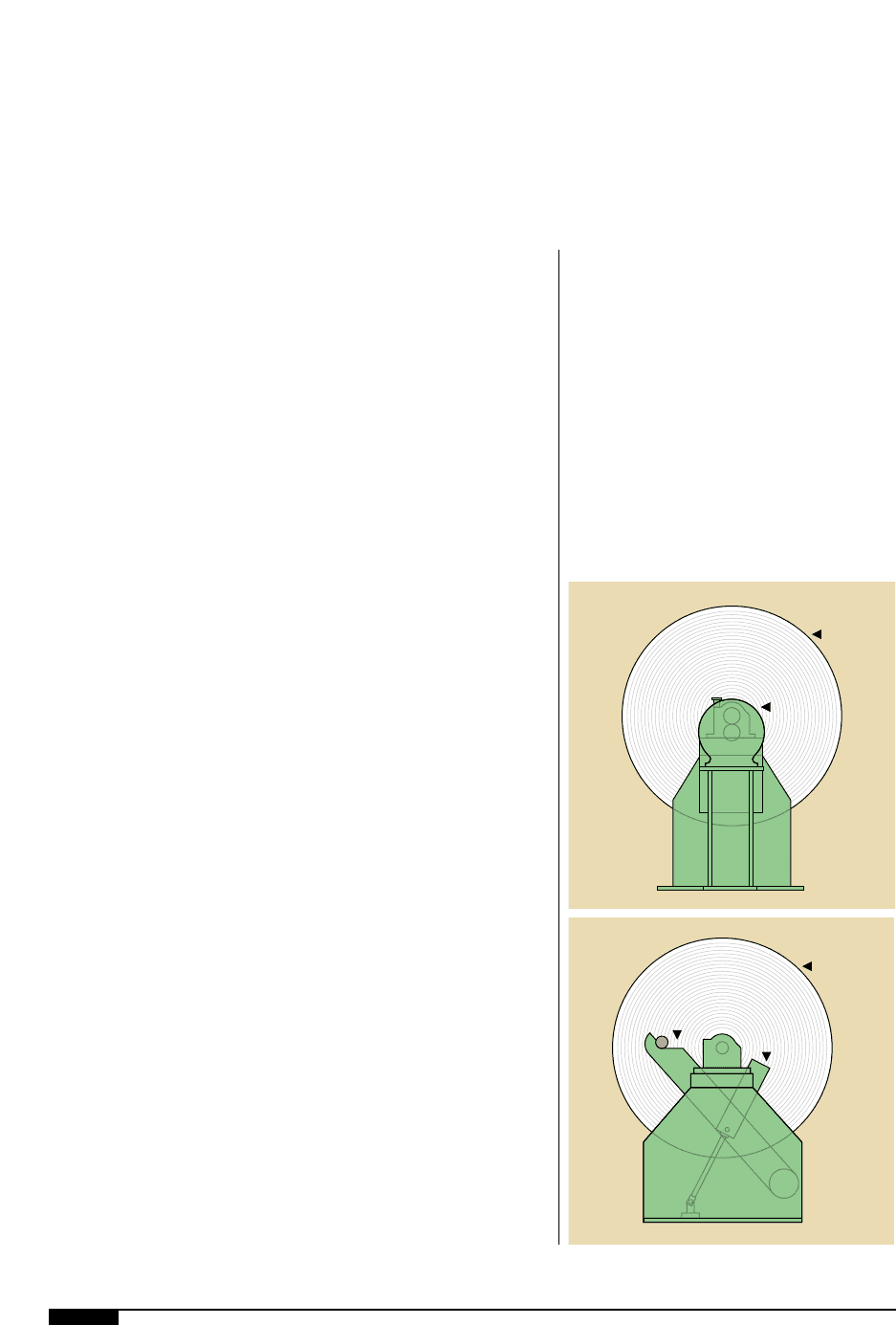
44 FLEXOGRAPHY: PRINCIPLES & PRACTICES
Unwind Equipment
1&
The single-position
unwind is the most
common type of
unnwind stand.
1*
Single-position unwind
with loading arms
facilitates the loading
of rolls.
T
he unwind stand, which can be
simple or complex, plays an
important part in the proper
operation of the press. There are
two general groups of unwind
stands: single-position and flying-
splice stands. Most single roll and older drop-
splice unwind stands are non-driven, while
most modern flying-splice unwinds are of the
driven type. A brief discussion later will cover
both center-shaft and surface-drive types.
SINGLE-POSITION UNWIND
The simplest and most common type of
unwind stand is the single-position stand. It
can be manufactured to handle a great vari-
ety of roll widths and diameters (Figure
1&
).
To make the stand more usable, designers
normally incorporate a side shift adjustment
so the core shaft may be moved by the oper-
ator either way from its center position. This
adjustment allows the operator to relocate
the web without having to shift the roll on the
core shaft. For wide, large-diameter rolls, a
loading apparatus may be used. Hydraulic
arms may be added to the stand to facilitate
the loading of rolls (Figure
1*
). Other
arrangements, such as overhead hoists or
tram rails, have found applications.
The most important function of an unwind
stand is uniform tension control during the
unwinding of the material to the printing
sections. Also, the unwind stand can be
automatically guided to provide lateral web
position control at the press in-feed. The sec-
ond most common single-position unwind
stand is the shaftless type (Figure
1(
). This
stand uses the roll core as a support for the
material. The advantage of this system is
that the operator does not have to shaft and
unshaft rolls of material. Even with pneu-
matic shafts, this chore becomes quite diffi-
cult when handling wide rolls. A further
sophistication of a shaftless stand is the self-
loading type (Figure
2)
).
In general, single-position roll stands are
used where large diameter mill rolls contain
sufficient footage to keep the press running
for a reasonable time between changes.
Parent Roll
Brake
Parent Roll
Hydraulic
Cylinder
Loading
Arms
1&
1*
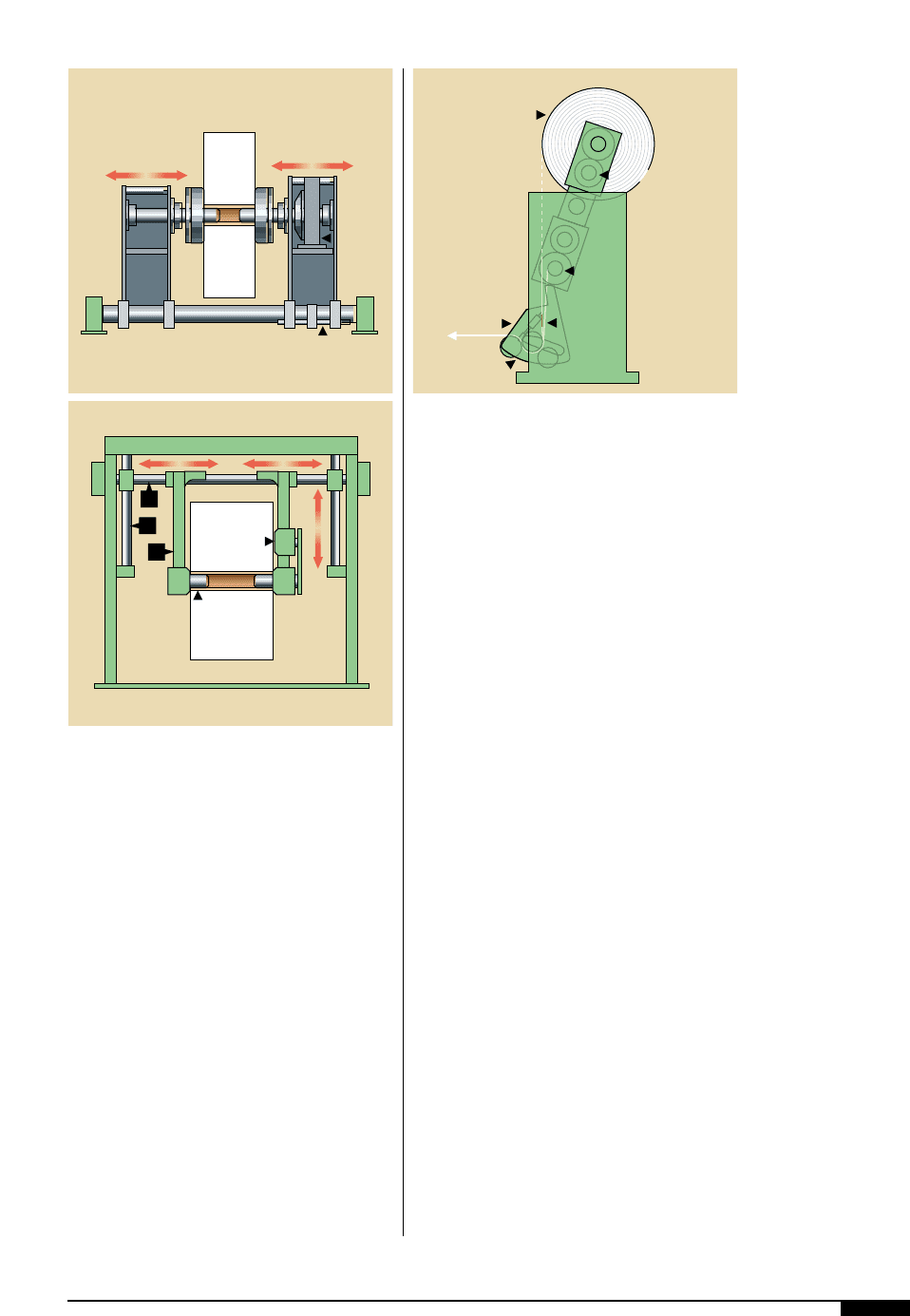
When changes become frequent, considera-
tion must be given to flying-splice systems,
which, although more expensive, increase
the printing output.
FLYING-SPLICE UNWIND
There are many types of flying-splice
stands available. They are classified with
respect to their roll diameters. Flying-splice
stands for the packaging industry generally
are capable of handling up to 24" or, in some
cases, 32" diameter rolls. Other stands for
handling heavier laminates and paper are
available with diameters up to 60". It is not
uncommon to see flying-splice stands capa-
ble of handling 72" diameter rolls where fair-
ly heavy board stock is being run.
Figure
2!
illustrates a typical 24" diame-
ter, simple drop-splice unwind stand for
common packaging materials such as poly-
ethylene and other extensible films.
In this sketch, note that this simple unwind
is semi-automatic in operation since it
requires the operator to “drop” the splice into
the splicing rolls. Drop splices are made by
placing the pre-taped, leading edge of the
new roll into the pneumatic or hydraulically-
loaded marriage rolls that press the tape onto
the expiring web. Operator skill is required to
determine the precise moment to make the
splice, in order to keep the tail of the expiring
roll to a minimum. The operator also has to
index the turret into the proper splicing posi-
tion. Most modern stands are made to accept
both “underwound” and “overwound” rolls.
Indexing the turrets can be done with either
electric or hydraulic motors.
Larger roll diameters and the demand for
more uniform color throughout the roll lead
to a need to drive the full roll during splicing.
Rolls weighing 500 lbs. to 800 lbs. are very
difficult to move, making a successful “drop”
splice at running speeds where matching
web sped is required virtually impossible.
An improvement in this type of stand is
to drive the new roll of material so that it
is traveling at the same linear speed as the
expiring roll. The new roll can be driven
PRESSES AND PRESS EQUIPMENT 45
1(
The shaftless unwind
uses the roll core as a
support tor the material
and is the second most
common single-position
unwind because the
operator does not have
to shaft and unshatf
rolls of material.
2)
A more sophisticated
shaftless unwind
self-loads the material.
2!
Flying splice unwind is
a simple unwind, semi-
automatic in its opera-
tion, since it requires
the operator to “drop”
the splice into the splic-
ing rolls.
Assembly A moves in and out on lead screw B
and up and down on lead screw C
B
A
C
Brake
Core chuck
New Mill Roll
Moveable
Cradle
Splicing
Rolls
Expiring
Mill Roll
Tape for
Splicing
Tension Brake
2)
2!
Parent Roll
Brake
Side Adjusting
Screw
1(
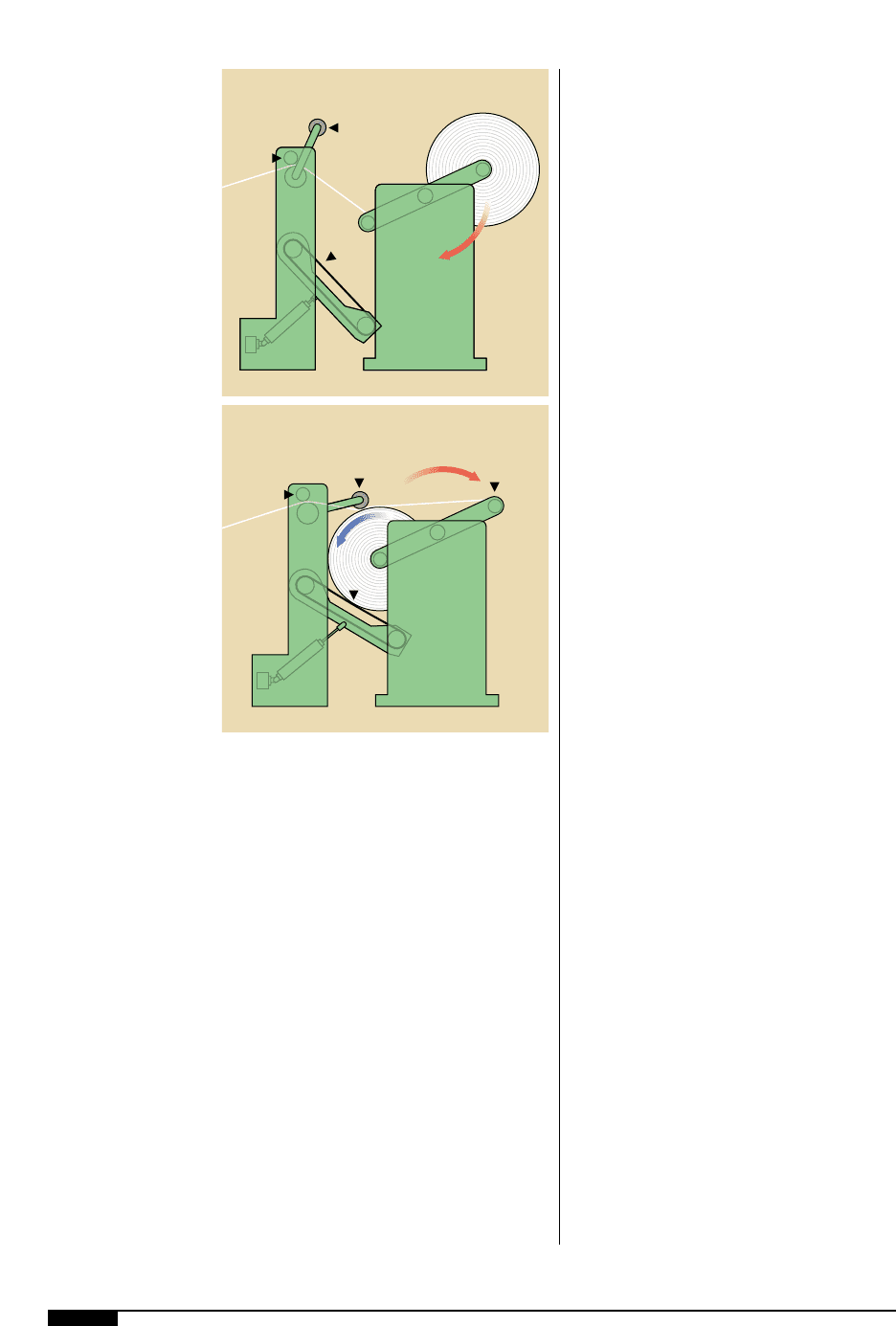
46 FLEXOGRAPHY: PRINCIPLES & PRACTICES
with a center-shaft or surface-drive sys-
tem. In the center-shaft system, the new
roll is accelerated to the proper splicing
speed by an adjustable speed drive, which
is usually a direct current (DC) motor or
an alternating current (AC) eddy current
drive. A hand-held or machine-mounted
tachometer controls the drive motor to
properly match the new web speed with
the expiring web speed.
In the surface-drive method, an air cylin-
der pushes a drive belt into engagement with
the new roll surface. The belt is driven by
mechanical means at line speed. In order to
accelerate the roll smoothly, a pneumatic
clutch gradually engages the belt.
The splicing operation in either case is
normally the same. The leading edge of the
new roll is pre-taped, and held in place by
two or three pieces of “breakaway tape” to
keep it from unwinding as the parent roll is
brought up to speed. When the roll reaches
the proper speed, an air-loaded rubber roll
forces the expiring web against the new par-
ent roll. As the pre-taped leading edge of the
new roll comes in contact with the expiring
web, the breakaway tape releases and the
transfer is completed. As with the “drop”
method, the transfer is at the operator’s dis-
cretion and the amount of tail left on the
expiring web depends on the operator’s skill.
Figures
2@
and
2#
describe the automatic
splicing sequence for an “over” splice.
This type of unwind splicing can be auto-
mated by using a knife to cut the expiring
web after the transfer is made. In this case,
the knife may be mounted on the same pivot
arm that holds the rubber bumper roll. There
is usually a delay between the actuation of
the bumper roll and the knife. This delay is
to ensure that contact has been made with
the pre-taped leading edge of the new roll
before cutting.
This automated system eliminates some
of the operator’s responsibility. It will leave
a minimum tail equal to the circumference
of the new parent roll. The amount of tail
can be minimized by adding an electric eye
to the system to sense the position of the
pre-taped leading edge of the parent roll
and, at the proper time, signal the actuation
of the bumper roll and the splicing knife. Of
course, this type of unit is more expensive.
Although it is possible to obtain shaftless
flying-splice unwind stands, these units are
usually too expensive to be considered on
most flexographic press applications. They
are commonly used where a large mill roll of
board stock is to be run. There are also sig-
nificant differences in unwind stands for
rolls up to 72" in diameter when compared
with others described, with respect to the
splicing method.
In the case of board, a double thickness
2@
Splicing operation
where the turret is in
loading position.
2#
Splicing operation
where the turret is in
splicing position.
Contact with the belt
starter brings the new
roll up to speed.
Pinch
Roll
Bumper Roll
Belt
Starter
Pinch
Roll
Bumper
Roll
Out-Running
Core
Belt
Starter
2@
2#

PRESSES AND PRESS EQUIPMENT 47
of an extremely heavy material can ruin the
flexo printing plates. Therefore, a butt
splice must be made instead of the previ-
ously described lap splices. Butt splices
can be made either manually or automati-
cally. For manual splices, an accumulator
or festoon in a two-position unwind is
required. While one roll is in operation, the
second unwind is being loaded with a new
roll. When the expiring roll reaches its end,
the leading edge of the new roll is manual-
ly taped while the press continues to be fed
by a web that has been stored. The amount
of web to be stored in the accumulator or
festoon is determined by the web speed
and the time needed to make the manual
butt splice.
There is equipment available for making
automatic butt splices. This splice is gener-
ally formed in three operations. At the time
of splicing, the new web is fed through a
set of rolls; both webs are cut to give
square edges and are then positioned end
to end. In this position, they travel to the
next set of rolls, where splicing tape is
applied to both sides of the web. From this
point, they travel to the next set of rolls,
which are marriage rolls, to ensure that the
tape applied at the previous operation is
securely bonded. The web then travels its
normal path.
UNWIND TENSION SYSTEMS
In general, there are two basic types of
unwind tension control systems. Each type
can use the same tension-sensing devices.
The most common tension control is the
unwind braking device employing air, elec-
tric or manually adjustable brakes. The
other system uses either air, electric or
hydraulic motors to drive the unwind shaft
to release a predetermined amount of mate-
rial into a tension-sensing device.
Unwind tension control is necessary for
good register. Control is especially neces-
sary on stack and central impression press-
es. Sufficient unwind web-tension must be
applied to maintain an even flow of material
into the printing section. Further, the tension
value must not be so high that it can cause
slippage in the in-feed draw roll section, or
so low that there is not sufficient tension to
properly track the web. Materials that
require the least tension (in pounds per lin-
eal inch) are the most difficult to handle. In
general, when unwinding materials, the ten-
sion values are roughly half the intermediate
and rewind tensions. Table 2 lists some com-
mon converting materials and some typical
unwind tensions for them.
In the unwind braking system, the brak-
ing power is decreased as the material
unwinds. A controlling device such as a
dancer or a load cell may be used to auto-
matically regulate any type of brake.
The braking system has some control
problems when the product of the tension
range and roll diameter buildup exceeds
100-to-1. Problems occur when:
TENSION
ROLL DIAMETER
DIFFERENCE DIFFERENCE
100
Where:
TENSION
MAXIMUM
MINIMUM
DIFFERENCE TENSION TENSION
ROLL DIAMETER
MAXIMUM ROLL
CORE
DIFFERENCE DIAMETER DIAMETER
On narrow webs where low tension val-
ues must be held, overcoming core-shaft
inertia and gearing-friction loads may take
away all of the brake’s sensitivity and hin-
der its proper control of web tension.
Further, if the press speed is high and the
core shaft and brake gearing have a high
inertia value, then as the roll diameter
decreases, the brake may be turned to a
zero setting. Even at a zero setting, the ten-
sion value in the web can still be too high,
thereby stretching the web to overcome the
high inertia value.
The second most common unwind-tension
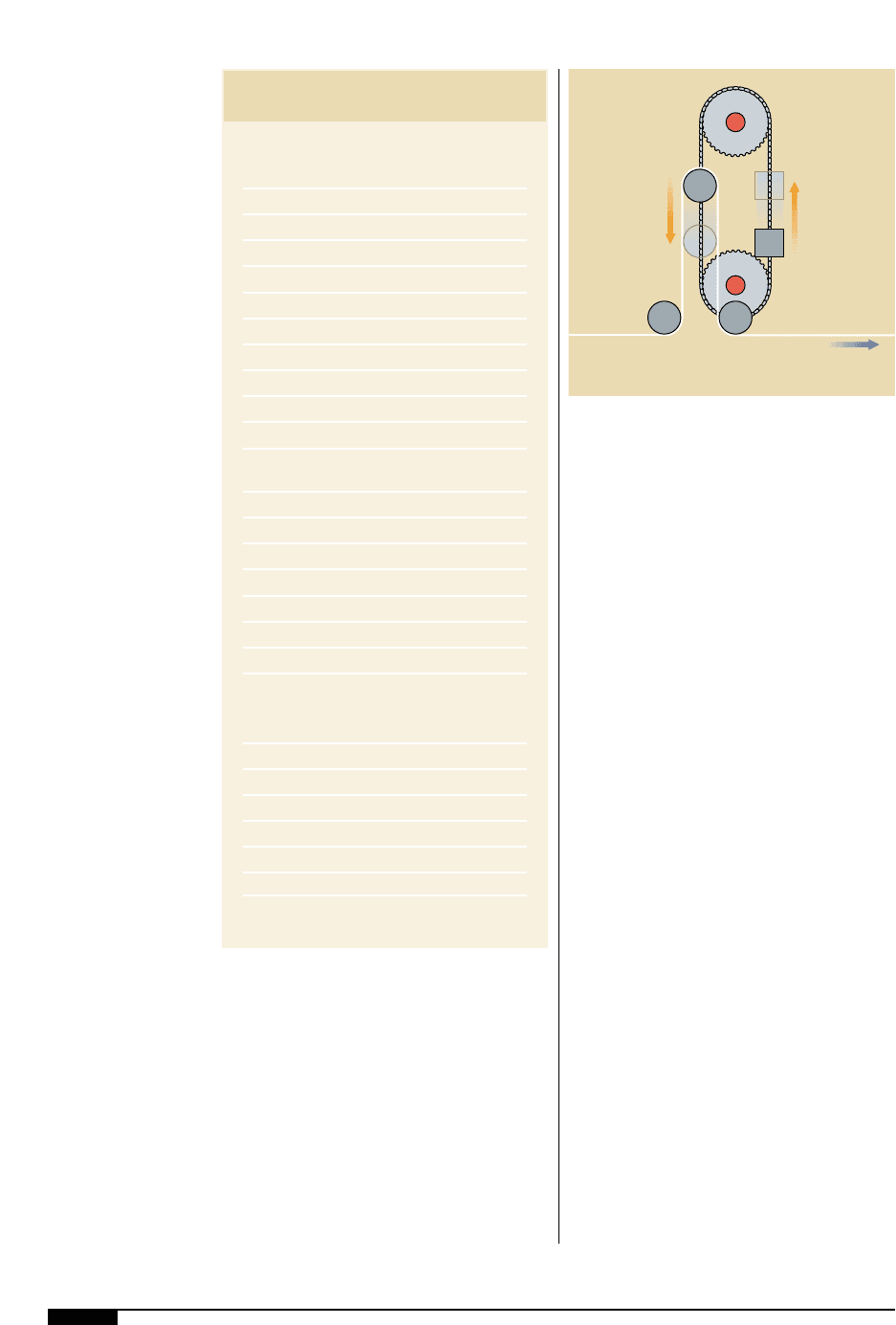
48 FLEXOGRAPHY: PRINCIPLES & PRACTICES
system is the driven type. A DC motor drives
the parent roll shaft, feeding the material
into a control system. The feedback signals
from a tension device control the motor
speed, thus maintaining preset tensions. The
horsepower required to drive the unwind
roll by the driven method is basically the
same formula as used when calculating the
horsepower for rewind drives, except that
the roll inertia is a factor to be considered.
However, the tension values are in the range
of 50% of the rewind values, therefore horse-
power requirements are lower.
One basic controlling system is a dancer
roll, which has a force applied to it by
weights, air cylinders or load cells to estab-
lish a predetermined loading of the web.
While the machine is running, the roll is
expiring and decreasing in diameter. As the
diameter decreases, the movement of the
web arm becomes shorter. This means that
the basic braking force applied initially to
the roll to counteract the dancer system is
no longer in balance. As the roll decreases in
size, the braking force becomes larger in
value and applies more tension to the web.
This unbalanced condition changes the
dancer-roll position and adjusts the electric
brake rheostat, or an air-control valve in the
case of air brakes. The controls decrease the
braking force sufficiently to once again put
the system in balance, maintaining the initial
tension value. With heavy rolls, it may be
necessary to have an auxiliary control cir-
cuit for stopping the mill roll as the press
stops. This control can be called an anti-
flood device.
Figure
2$
shows a typical weight-loader
or pneumatically loaded dancer system.
Another type used is a load-cell controlled
2$
A typical weight-loader
or pneumatically loaded
dancer system.
Table 2
MATERIAL TENSION
(per mil per inch of width)
Acetate 0.25 lb.
Foil (aluminum) 0.25 lb.
Foil (copper) 0.25 lb.
Cellophane 0.375 lb.
Nylon 0.125 lb.
Polyethylene 0.06 lb.
Polyester 0.375 lb.
Polypropylene 0.125 lb.
Polystyrene 0.50 lb.
Saran 0.075 lb.
Vinyl 0.025 lb.
Paper* (per inch of width)
15 lb. 0.20 lb.
20 lb. 0.25 lb.
30 lb. 0.375 lb.
40 lb. 0.625 lb.
60 lb. 1.00 lb.
80 lb. 1.50 lb.
100 lb. 2.00 lb.
*based on 3,000 sq. ft. ream
Paperboard (per inch of width)
8 pt. 1.5 lb.
12 pt. 2.0 lb.
15 pt. 2.25 lb.
20 pt. 2.75 lb.
25 pt. 3.25 lb.
30 pt. 4.0 lb.
For laminated webs, sum the tensions for the
individual webs and add 0.10 lb. per inch of width
TYPICAL UNWIND TENSION
FOR WEB MATERIALS
Web
Fixed Roll
Endless Chain
or Timing Belt
Dancer Roll
Movement
Weight or
Pneumatic
Actuator
Movement
Constant tension is maintained as
the web loop varies in length
Sprocket with
Feedback
Potentiometer
2$

tension system. The load cell or tension
transducer system is widely used for con-
trolling unwind tensions. It has the disad-
vantage of being a short-stroke dancer, so it
does not have the storage capacity to absorb
the shock of splicing. For this reason load
cell systems are normally used with single-
position unwind stands or with automatic
splicing units, which drive the full roll to pre-
vent the shock load that occurs with a man-
ual drop-type splice. The load cell arrange-
ment works on the strain-gauge principle as
previously described (Figure
1%
). Web ten-
sion applies a force to the idler roll which, in
turn, is transmitted to the load cell. The most
minute change in tension causes the strain
gauge to change its electrical signal output.
This signal is amplified and then sent to the
unwind brakes to adjust their braking
power. Similar devices are available that, by
very small movements, create air-pressure
signals that are amplified and transmitted
back to either air or electric brakes.
The basic purpose of the unwind braking
system is to apply just enough holdback
force to the expiring roll to maintain a con-
stant tension into the printing section.
IN-FEED UNIT
The function of the in-feed is to present
the web to the print section at a constant
feed rate and tension. It is normally located
prior to the first print deck on a stack press
or in-line press and is usually a three-roll sys-
tem comprised of two driven steel rollers
and a rubber pressure roller that is air or
hydraulically loaded. The in-feed pulls the
web from the unwind roll and helps estab-
lish the first tension zone in the press.
Tension in the unwind section is established
by braking the unwind roll. The in-feed also
serves to isolate the tension in the print sec-
tion from the unwind tension and becomes
the nip point for a new tension zone through
the print and drying sections.
On central impression presses, the CI drum
becomes the pulling element and the rubber-
covered nip roll, which secures the web to
the drum, the in-feed. Because of the amount
of web wrap (about 85% of the drum’s cir-
cumference), it is only necessary to secure
the web to the drum to have constant feed.
The in-feed plays a vital role in maintain-
ing tension and in controlling register.
Forgetting to activate the nip roller has cre-
ated more than its share of problems. Also to
be considered is the hardness of the rubber
roller and the amount of pressure used. Most
press manufacturers will specify hardness,
but lacking any specifics, one has to rely on
experience or trial and error.
Also associated with the in-feed is a
spreader roll, which functions to present a
smooth, wrinkle free web to the print sec-
tion. There are a variety of opinions as to the
type of spreader to use or whether one is
really necessary. A spreader roll is normally
a factory option.
Many converters believe a bowed roll or
“banana” roll is the wisest choice. The bowed
roll will be driven either by a belt with an
adjustable pulley, or in some cases, will have
the luxury of an independent DC drive. If a
bowed roll is the preferred choice, the con-
sensus of opinion is that a roll should be of
such a design as to enable the operator to
vary the bow. This option allows the operator
optimum control to facilitate eliminating
problems such as gauge bands. Less effective,
but in many cases preferred, is a non-driven
spiral, grooved roll constructed of rubber, alu-
minum or steel that is designed to spread the
web. The action of the spirals, which are cut
from the center to the end of the roll, has the
same effect but not as dramatic as a bowed
roll, and is available at a lower cost.
OUT-FEED UNIT AND/
OR COOLING DRUM
The function of the cooling drum unit par-
PRESSES AND PRESS EQUIPMENT 49

50 FLEXOGRAPHY: PRINCIPLES & PRACTICES
allels the function of the in-feed. It provides
an even, constant pull through the print sec-
tion and also serves to isolate the print sec-
tion tension zone from the rewind tension
zone. It consists of one or more chill rolls
with a rubber-covered nip roll to secure the
web to the chill roll and prevent slippage.
The drive is variable through a variable-
speed unit or, on the latest presses, by
means of an independent DC drive motor.
Earlier presses drove the chill roll
mechanically at a fixed rate of over-speed.
These drives were speed sensitive and could
not handle a variety of substrates. The vari-
able speed mechanical drive was then devel-
oped, which allowed the operator to adjust
the tension to accommodate the various
substrates, or those that had some imperfec-
tions. The most recent development is the
DC drive, which gives automatic control
over a wide range of tensions. Again, experi-
ence becomes vital in setting the tension in
this zone, but once the experience is gained
it can be repeated. It is only necessary to
input the desired tension; the automatic con-
troller then goes to work. The biggest prob-
lem encountered in this area is failure to
lower the nip roll, resulting in misregister
and other negative-tension problems.
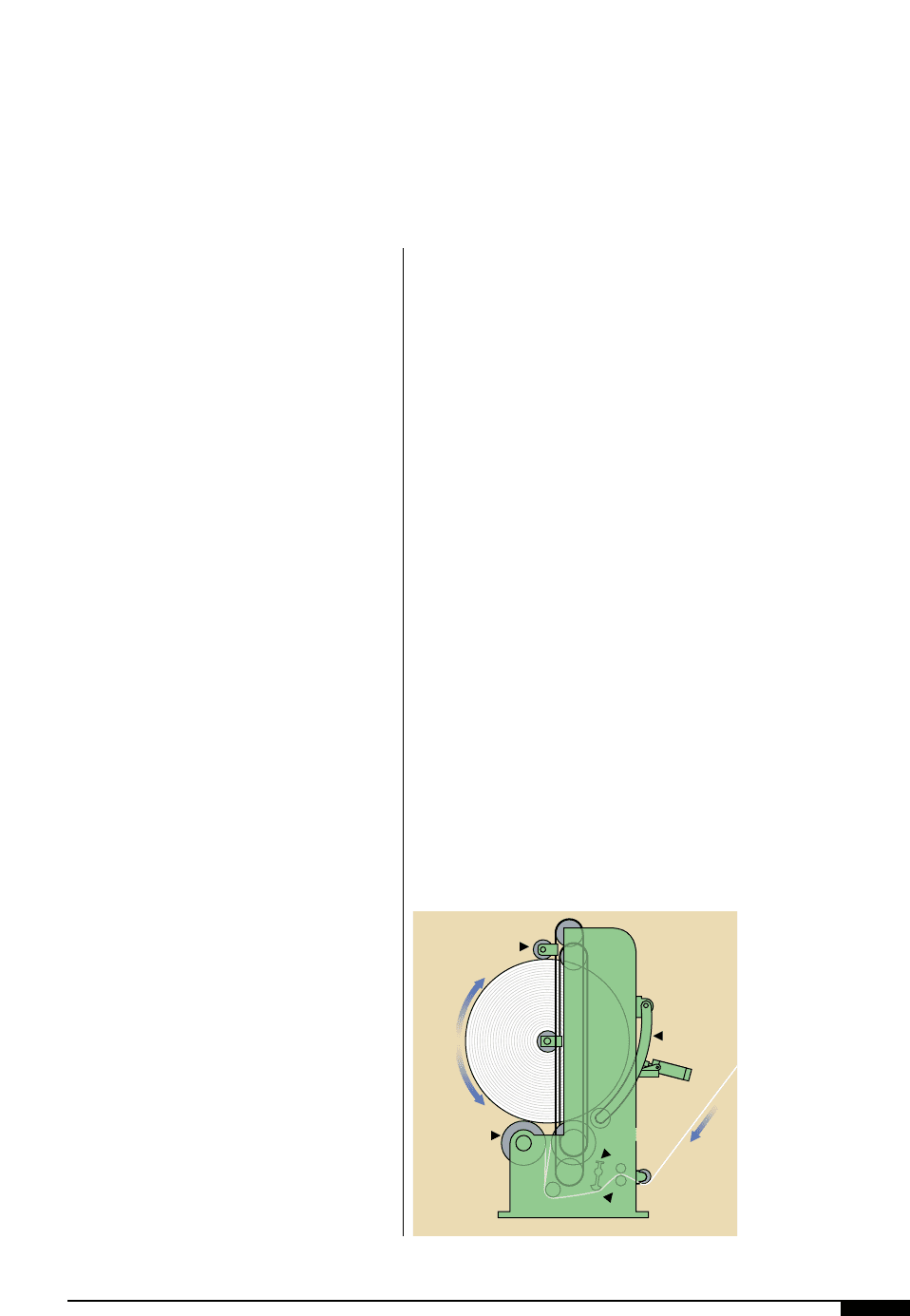
PRESSES AND PRESS EQUIPMENT 51
Rewind Equipment
2%
The double-drum
rewind, the most
common type of surface
rewinder, uses two
equal-diameter winding
drums to drive the web.
T
here are two basic classifications
for rewinding equipment: center
and surface winding. Some sin-
gle-roll rewinds use a combina-
tion of center and surface drives.
Flying-splice rewinders are nor-
mally of a center-wind type. Although there
are automatic flying-splice surface winders,
they are normally used in the paper industry.
SURFACE WINDERS
Surface rewinding units use the surface of
a moving roll to impart rotation, by friction-
al contact, to the roll being wound. There
are two surface rewind designs common to
the industry.
Double Drum
The double-drum rewind is the most com-
mon type of surface rewinder and is de-
scribed in Figure
2%
. It uses two rolls of
equal diameter to drive the web. The rewind
unit is usually driven by a variable-speed
drive to set the basic tension pattern.
Normally, one roll is also driven slightly
faster than the other to provide a differential
surface speed, creating a hard roll. The
winding drive rolls can also be fluted to
reduce wrinkling and give additional roll
hardness. As shown in the illustration, the
printed roll can be wound with the printed
surface in or out, depending on the method
of threading. The center of the roll, the core
shaft, moves vertically upward as the roll
diameter builds. The increasing weight of
the roll on the winding drums assists in
obtaining a tightly wound roll.
A rider roll can be supplied with a dou-
ble-drum rewind unit. The rider roll rests
on top of the roll being wound, and can be
pneumatically or hydraulically loaded to
provide a greater nip pressure between the
roll and the winding drums. The pressure
of a rider roll should be gradually lessened
during the rewinding cycle to provide more
uniform pressure.
Hydraulic or pneumatic loading of the roll
core shaft is another accepted method of
increasing nip pressure. The hydraulic cylin-
ders act to maintain a uniform or steadily
decreasing pressure relationship between
the roll being wound and the winding drums.
Maintaining uniform pressure is easier to
accomplish on a single-drum winder be-
cause the method of loading doesn’t have to
overcome or compensate for the increasing
roll weight.
Single Drum
The single-drum rewind unit (Figure
2^
)
uses the same surface-winding principles
as the double-drum unit, but has a single
Rider Roll
Mill Roll
Booster
Winding
Drums
Slitter Station
Spreader
Bar
2%
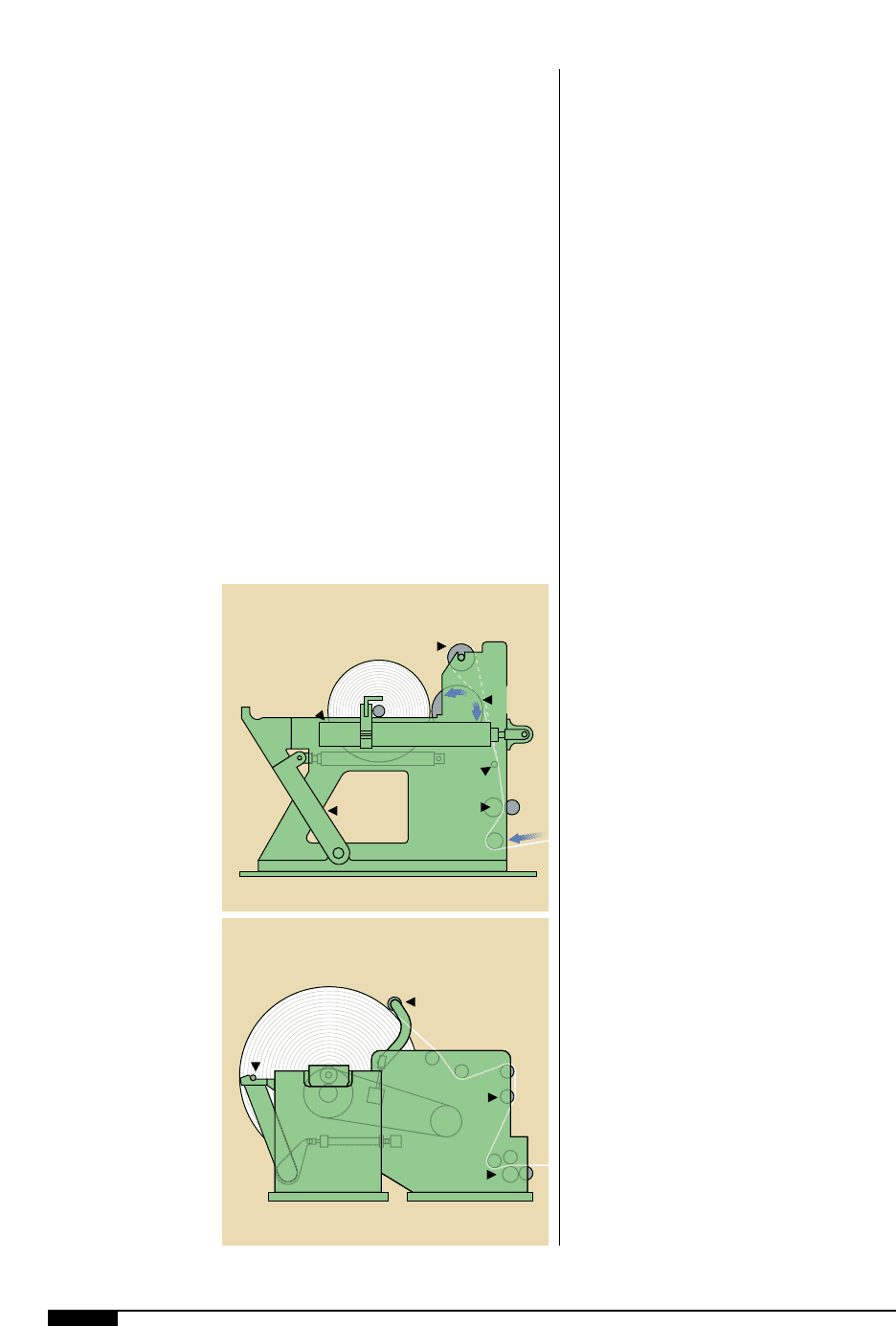
52 FLEXOGRAPHY: PRINCIPLES & PRACTICES
drum to impart rotation. It is also driven
with a variable-speed drive to set the basic
tension pattern.
The roll being wound moves horizontally
rather than vertically during buildup. Hydrau-
lic or pneumatic pressure is applied to main-
tain a regulated roll pressure between the roll
and the winding drum. This pressure can be
varied to provide different roll densities and
hardness. As in the double-drum rewind, the
printing can be wound inside or out.
One of the main advantages of surface-
rewinding equipment is the ability to obtain
very dense and uniformly wound rolls with
most grades of paper. Also, rewinding can be
accomplished with less horsepower than
required with center-winding equipment.
More attention must be paid to minimum
roll widths with a single-drum rewind
because of shaft deflection. The minimum
roll width is usually restricted to 80% of the
maximum roll width.
Because a rotating surface imparts motion
to the sheet through friction contact, this
equipment is generally limited to materials or
products that don’t have slippery surfaces, are
not easily stretched, and can withstand some
rubbing or scuffing action. A waxed sheet sur-
face, for example, might be wound more
effectively on center-winding equipment.
Either score- or shear-slitting units lend
themselves readily to surface-winding meth-
ods. The slitting station is mounted before
the winding drums to reduce the travel
length of slit webs to ensure there will not be
web interleaving.
Roll unloading equipment is available on
both single- and double-drum rewinding
units. Hydraulic or pneumatic means can be
provided to either lower the roll out of the
winding machine or to push the finished roll
onto a loading platform or dolly.
CENTER WINDERS
Center winding gets its rotary movement
through the core shaft. The center-winding
units are available both as core-shaft and as
shaftless types. On flexo presses, the most
common center-shaft winder is the core-
shaft type.
A common center-shaft winder is the sin-
gle-position type described in Figure
2&
.
This design employs one core shaft mounted
in frames. The shaft is driven by an electric,
mechanical, hydraulic or combination drive
with some means of adjusting the drive
speed to vary the roll hardness. The single-
position type must be stopped for roll
changes. The rider roll is also driven on more
modern designs.
A rider roll is frequently used in both sin-
gle- and flying-splice center rewind units. Its
purpose is to help get a hard and uniform fin-
2^
The single-drum rewind
unit uses the same sur-
face-winding principles
as the double-drum
unit, but has a single
winding drum to impart
rotation.
2&
A single-position center
shaft rewind unit with
web slitter. This com-
mon design employs
one core shaft mounted
in frames. The shaft is
driven by an electric,
mechanical, hydraulic
or combination drive
with some means of
adjusting the drive
speed to vary the roll
hardness.
Bypass-Reverse Wind
Slitter
Station
Spreader
Bar
Roll
Unloading
Arm
Roll
Loading
Cylinder
Winding
Drum
Slitter Station
Expander roll
Roll
Unloading Arm
Rider Roll
2^
2&
